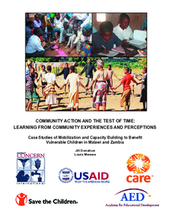This study, carried out by Jill Donahue and Louis Mwewa and guided and supported by a multi-agency steering committee, documents visits to 30 communities in Malawi and Zambia, where the initial mobilization and capacity building work was done as long as ten years ago. A key aim was to find out what (if anything) these communities are still doing for children and why these efforts have continued.
The findings are encouraging and have specific implications for current programming across a range of contexts where action is needed for vulnerable children. The study found that mobilizing community action for especially vulnerable children is worthwhile and sustainable, but that how this work is approached and supported makes a difference in these critical outcomes.
The findings and implications for programming include:
-
A key element in sustained action was “ownership,” the sense among community members that the problems identified are theirs and that they hold primary responsibility for addressing them.
-
The impetus for action should emerge from the community itself.
-
An external organization needs to formulate its agenda around community priorities, concerns, capacities, and commitments.
-
It is important to link grassroots groups to structures and resources and at district or higher levels.
-
Community groups can determine which children are the most vulnerable and effectively manage ongoing efforts to address their needs.
-
Factors that motivated sustained action by community participants included: compassion for children, a sense of unity, creation of a common vision, and broad community involvement.
An effective mobilization strategy helps communities:
-
Analyze their situation and discuss the implications,
-
Identify internal community resources (e.g. knowledge, individual skills and talents, land, ingenuity),
-
Identify priority needs,
-
Develop a strategy to address their priority needs, and
-
Plan activities needed to execute their strategy using internal resources initially.
The real significance and utility of this study depends not only on its findings about how to do effective community mobilization and capacity building. The report may be even more valuable if it helps agencies and donors reflect more deeply and carefully on how they are relating to communities and helps generate on a much wider scale effective partnerships with communities.
©USAID

